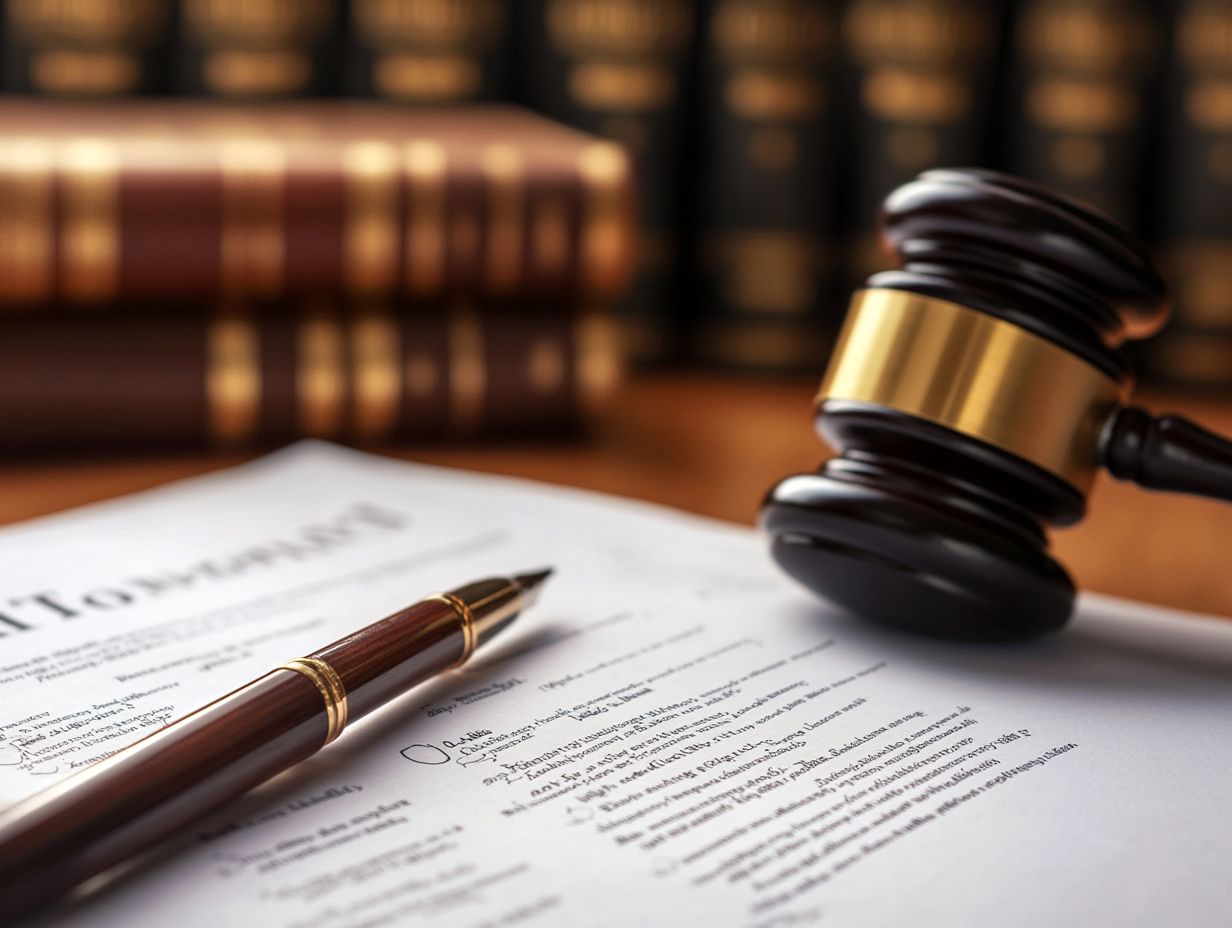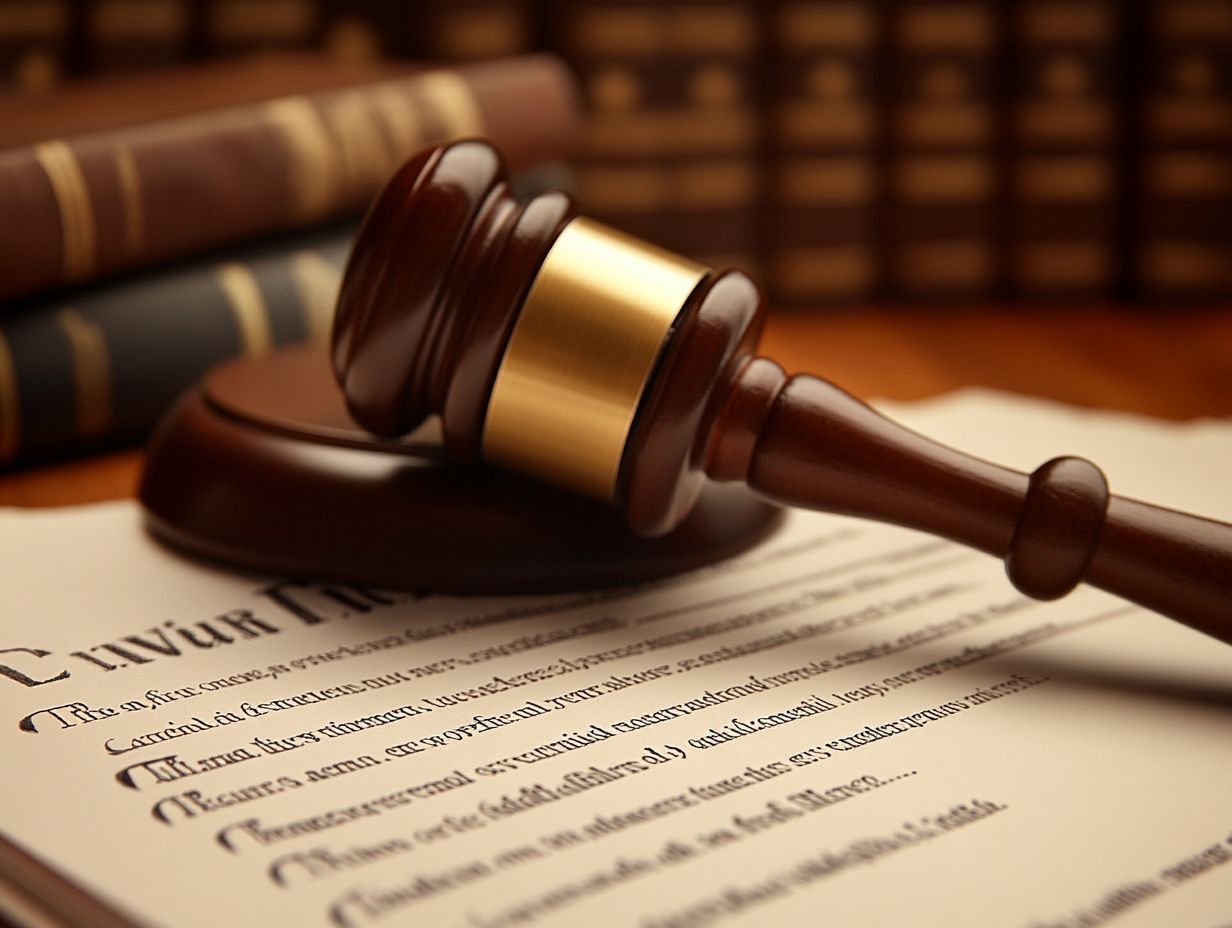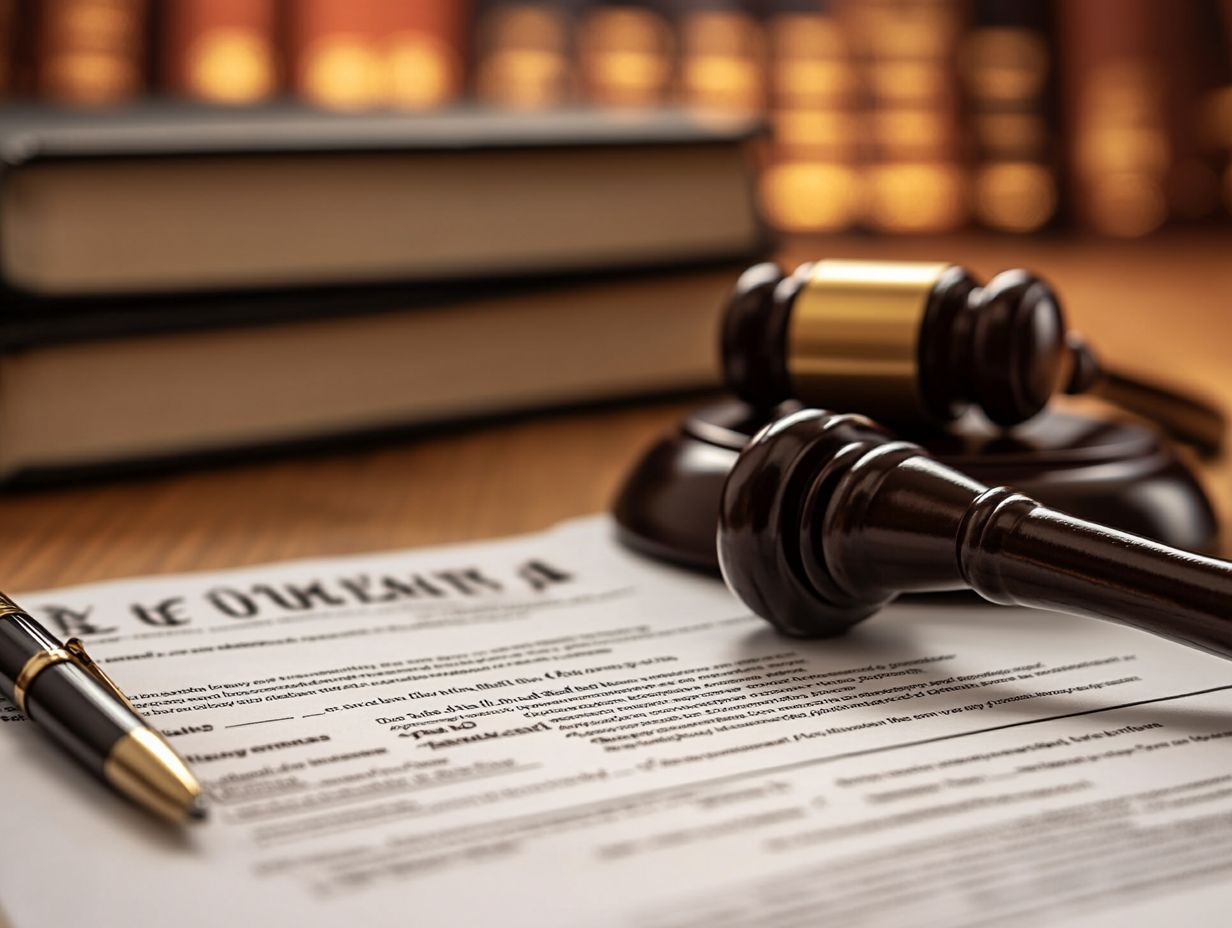The Legal Framework of Licensing Agreements Explained
Licensing agreements are pivotal in the realm of intellectual property. They enable creators to share their innovations while safeguarding their rights.
This article explores the different types of licensing agreements exclusive versus non-exclusive. It clarifies the distinctions between patents, trademarks, and copyrights.
It examines the rules that govern these contracts and highlights the essential elements for their effectiveness. You ll find practical negotiation tips that are invaluable, along with insights into common disputes and strategies for resolution.
By the end, you ll finish this article ready to tackle licensing with confidence and excitement!
Contents
- Key Takeaways:
- Types of Licensing Agreements
- The Legal Framework of Licensing Agreements
- Key Elements of a Licensing Agreement
- Negotiating a Licensing Agreement
- Common Issues and Disputes in Licensing Agreements
- Frequently Asked Questions
- What is the legal framework for licensing agreements?
- Why is understanding the legal framework of licensing agreements important?
- What are the key elements of a licensing agreement?
- What are the different types of licensing agreements?
- How do you ensure a licensing agreement is legally binding?
- What happens if one party breaches the licensing agreement?
Key Takeaways:

A licensing agreement is a legal contract between two parties. One party grants the other the right to use their creations of the mind, like inventions and brands, in exchange for compensation. For more details, refer to our guide on understanding licensing agreements in IP strategy.
The guidelines for licensing agreements are based on both contract law and intellectual property law. To fully grasp the nuances, it’s important to explore understanding the implications of licensing agreements, as these laws govern the terms and conditions, royalties, and disputes.
Successful negotiation of a licensing agreement requires a thorough understanding of both parties’ rights and responsibilities. Clear communication is vital to avoid potential conflicts or disputes in the future.
What is a Licensing Agreement?
A licensing agreement allows you, as the licensee, to use intellectual property (IP) with permission from the licensor. This agreement lays out the specific terms and conditions under which you can operate.
It s essential to focus on key elements like payment terms and confidentiality provisions. These are designed to protect the integrity of the licensed material.
Confidentiality clauses are crucial because they keep sensitive information private and prevent it from falling into competitors’ hands. With clearly defined rights, both you and the licensor can understand each other’s responsibilities.
Quality control stipulations ensure that the licensed products or services meet expected standards. This ultimately protects the reputation associated with the intellectual property.
By addressing these critical components, licensing agreements enhance business relationships and secure the value of the creative works involved.
Types of Licensing Agreements
Licensing agreements come in various forms, primarily classified into exclusive and non-exclusive licenses. Each is tailored to meet specific business needs and objectives.
An exclusive license grants the licensee sole rights to the licensed material within a specified territory. This creates a unique advantage.
Conversely, a non-exclusive license allows multiple licensees to use the same intellectual property. This promotes broader market expansion and collaboration.
Exclusive vs. Non-Exclusive
The main difference between exclusive and non-exclusive licensing lies in the rights you receive as a licensee. Exclusive licenses provide you with sole usage rights, enhancing your brand recognition.
Non-exclusive licenses permit multiple entities to share the intellectual property. Each operates under defined rights and obligations, impacting market share and competitive advantage.
For instance, an exclusive license can strengthen your market position, similar to technology firms that protect their innovations. In contrast, non-exclusive licenses, often used in publishing, enable wider distribution and accessibility of works.
This broader reach can build a larger audience but may dilute the original creator’s market presence. Both types come with risks of licensing breaches; exclusive agreements might lead to complacency, while non-exclusive contracts can spark disputes among licensees.
Understanding these dynamics is crucial for you as a business, especially if you aim to navigate your licensing options strategically.
Start exploring licensing agreements today to safeguard your innovations!
Patent vs. Trademark vs. Copyright
Understanding the distinctions between patent, trademark, and copyright licensing is essential for you as a business owner. Each type of intellectual property provides unique protections.
Patents shield your inventions and processes. Trademarks protect your brand identifiers, while copyrights encompass your original works. Each is regulated by different laws that shape licensing agreements and potential disputes.
These distinctions can greatly impact your business. For example, licensing agreements for patents can involve intricate negotiations regarding royalties. They may also be influenced by patent infringement lawsuits, much like the widely publicized case of Apple vs. Samsung.
On the flip side, trademarks can complicate licensing agreements when disputes arise over brand misuse, as seen in controversies surrounding unauthorized logo usage.
Copyright licensing can also present challenges, especially when it comes to derivative works, as seen in lawsuits involving musicians using samples. Each of these scenarios underscores the importance of grasping the nuances of intellectual property types. This knowledge allows you to navigate potential pitfalls and effectively safeguard your company s assets.
The Legal Framework of Licensing Agreements

Understanding the legal framework surrounding licensing agreements is crucial for compliance with both local and international laws.
Governing law clauses play a vital role; they clearly outline the jurisdiction and legal standards that will apply in any disputes.
Understanding and following these legal rules can help you avoid conflicts and strengthen your agreements.
Contract Law and Intellectual Property Law
The intersection of contract law and intellectual property law is crucial when crafting robust licensing agreements. These agreements safeguard your intellectual property while ensuring legal enforceability.
A well-drafted agreement outlines the rights and obligations of each party. It also anticipates potential disputes that may arise.
As a licensor, you need to ensure that the terms clearly specify the scope of use, duration, and territory covered. This helps prevent misunderstandings.
On the flip side, it s essential for you as a licensee to be aware of the legal standards governing these agreements. This awareness helps avoid pitfalls like unintended infringement.
Neglecting these details could lead to serious legal ramifications. These may include loss of rights or financial damages, especially if you inadvertently exceed the granted privileges.
Examining case studies where disputes have occurred highlights the necessity of meticulous attention to detail in these agreements.
Key Elements of a Licensing Agreement
A meticulously crafted licensing agreement contains essential elements that delineate the relationship between you, the licensor, and the licensee, highlighting the role of licensing agreements in intellectual property.
This includes clearly articulated terms and conditions, payment terms detailing licensing fees and royalties, and termination provisions specifying the conditions under which the agreement can conclude.
It also ensures that quality control standards are maintained throughout the entire licensing period. This protects your interests and maintains the integrity of your brand.
Terms and Conditions
The terms and conditions section of a licensing agreement lays out the specific rights and obligations for both parties. For a deeper insight, consider understanding the duration of licensing agreements, as this establishes a solid foundation for compliance and operational success within the deal.
This includes precise clauses on termination provisions. These clauses clarify how and when either party can exit the agreement.
Ambiguous language in these sections can lead to significant uncertainty. This uncertainty may result in disputes that necessitate legal intervention.
For instance, clauses concerning the scope of use might unintentionally permit a broader or narrower application than intended. This complicates the relationship.
Key elements like royalty payment structures and the duration of the license are crucial in defining each party’s responsibilities. By clearly outlining these aspects, both the licensor and licensee can minimize risks.
This promotes smoother collaboration, ultimately ensuring that expectations are met and maintained throughout the agreement.
Royalties and Payment Structure
Understanding the royalty payments and overall payment structure outlined in a licensing agreement is essential for both licensors and licensees. This knowledge dictates the financial arrangements of your licensing deal, covering everything from licensing fees to compliance with agreed-upon payment terms.
These agreements can take many forms:
- Flat fees
- Percentage-based royalties
- Milestone payments that hinge on achieving specific sales thresholds
You have the flexibility to negotiate the intervals for these payments whether they occur monthly, quarterly, or annually to suit your needs and preferences.
Clear payment terms are crucial in these agreements. They diminish the risk of misunderstandings and create a framework for timely compliance. By ensuring both sides are aligned on the payment structure, you can cultivate a more collaborative relationship and reduce the likelihood of potential disputes.
Negotiating a Licensing Agreement

Negotiating a licensing agreement requires careful strategic planning and a keen understanding of both parties’ objectives. By employing effective negotiation strategies, you can secure favorable terms that benefit both the licensor and the licensee.
It’s essential to engage legal counsel during this process to skillfully handle any challenges and ensure that every aspect of the licensing deal is thoroughly addressed.
Tips for a Successful Negotiation
Achieving a successful negotiation outcome in licensing agreements relies on your well-prepared approach. By understanding the needs of both parties and employing strategic negotiation tactics, you can significantly enhance the likelihood of crafting an agreeable contract.
This preparation involves gathering information about the other party’s interests and honing your active listening skills to foster a more open dialogue.
By doing so, you’re more likely to uncover hidden incentives and potential compromises that pave the way for win-win situations. For instance, consider a scenario where two companies are discussing licensing rights. One might be willing to offer extended payment terms in exchange for additional promotional support, creating a collaborative atmosphere rather than a contentious one.
Flexibility during the negotiation process can help mitigate potential conflicts, ensuring that all parties feel valued and understood while working towards a resolution that benefits everyone involved.
Common Issues and Disputes in Licensing Agreements
Common issues and disputes in licensing agreements often stem from ambiguous terms. This ambiguity can lead to potential breaches and financial disagreements, and even the need for legal intervention.
Understanding dispute resolution can make your life easier! By recognizing the significance of these mechanisms, you can adeptly navigate challenges whether you re a licensor or a licensee, ensuring a smoother and more effective process.
Resolving Conflicts and Protecting Rights
Effective conflict resolution in licensing agreements requires you to consider various dispute resolution mechanisms, such as mediation, arbitration, and sometimes legal intervention. These tools are crucial for safeguarding the rights of both parties and ensuring the longevity of your licensing partnership.
Each method plays a vital role in managing potential issues during the licensing period, presenting unique advantages and disadvantages.
For instance, mediation creates a collaborative atmosphere where you can work toward a mutually agreeable solution with a neutral facilitator, although it may not provide the binding authority some parties seek. On the other hand, arbitration is a process where a neutral party makes a decision to resolve a dispute, offering a more definitive conclusion but often comes with higher costs and less procedural flexibility.
Real-world case studies, like the resolution between two tech giants over copyright infringements, demonstrate how effective negotiation and well-structured dispute resolution strategies can resolve conflicts and pave the way for stronger future collaborations.
Frequently Asked Questions
What is the legal framework for licensing agreements?

A legal framework for licensing agreements includes laws and guidelines that define the terms of these agreements. It specifies the rights of the licensor, the owner of the creative work, and the licensee, the party using that work, along with understanding the legal implications of licensing agreements.
Why is understanding the legal framework of licensing agreements important?
Understanding this framework protects both parties and upholds their rights. It also helps avoid misunderstandings and disputes during the agreement.
What are the key elements of a licensing agreement?
Key elements include the definition of the work being licensed, the license’s scope, its duration, and payment terms. Confidentiality clauses and termination provisions are also important.
What are the different types of licensing agreements?
There are exclusive and non-exclusive agreements. An exclusive agreement gives one licensee the sole right to use the creative work, while a non-exclusive agreement allows multiple licensees.
How do you ensure a licensing agreement is legally binding?
To make a licensing agreement legally binding, both parties should sign a written contract outlining the terms. Understanding the key elements of licensing agreements is crucial, along with following relevant laws and having legal experts review the contract.
What happens if one party breaches the licensing agreement?
If a breach occurs, the other party can seek damages or terminate the agreement. This depends on the specific terms and applicable laws, making it essential for both parties to understand their rights.






